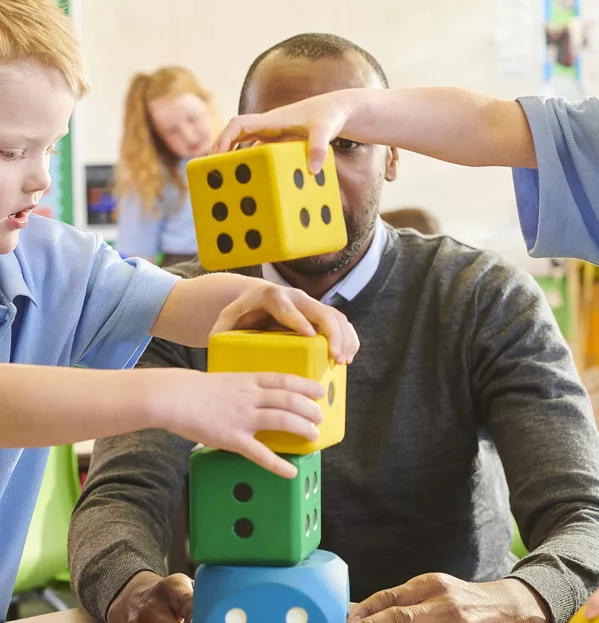Problem solving in early maths: 3 simple teaching tips
Share
Problem solving in early maths: 3 simple teaching tips
This article was originally published on 7 January 2024
Ed has made an enclosure for dinosaurs using four wooden blocks. He wants to make sure the dinosaurs can’t escape.
“Interesting, I can see the dinosaurs are all locked inside the enclosure,” says Ed’s teacher, “but the tyrannosaurus rex is very tall. I think it would be able to climb out? Is there something you could do to stop him escaping?”
Ed fetches four more blocks and stacks them on top of his enclosure, making it taller.
“Good thinking, Ed,” says the teacher, “but we can still see his head, so it might need to be taller. There are no more long blocks for you to use. I wonder what you could use instead?”
“I think lots of these shorter ones might fit on the top,” says Ed.
There are frequent opportunities for mathematical problem solving throughout a typical day in an early years setting. But how can we ensure that we maximise their impact when they arise?
- What would ‘phonics for maths’ look like?
- Is this the ‘right’ way to teach early maths?
- How to develop number sense
The Education Endowment Foundation’s Early Years Evidence Store identifies approaches that educators can use to support young children’s early maths learning and development, while providing a summary of the evidence behind each approach.
Created as part of the EEF’s work supporting the Department for Education’s Stronger Practice Hubs, the store has been co-developed by researchers and educators.
The newly published Early Mathematics theme recommends five approaches for supporting children’s maths development:
- Teaching the association between number and quantity.
- Promoting fluency with numbers and sequences.
- Teaching problem-solving skills for maths.
- Teaching and modelling how to make comparisons and connections.
- Facilitating mathematical language.
If we look at the third approach, teaching problem-solving skills for maths, this covers how we teach children to apply purposeful thinking, communicate their ideas and use manipulatives to solve problems.
Strategies for teaching early mathematical problem-solving skills
Evidence and experience tell us that explicitly teaching problem-solving skills can be effective when combined with other approaches, especially when matched to children’s level of development.
A multi-pronged approach is particularly important for children from lower-income families or those at greater risk of not meeting expected levels of development. Sequencing learning and breaking tasks down, as well as modelling problem-solving strategies, can also help to improve outcomes.
But what does that look like in practice?
1. Thinking aloud
In the example at the start of this article, Ed’s teacher models her mathematical thinking aloud, encouraging Ed to do the same. Deliberate modelling, meanwhile, provides opportunities for the teacher to suggest additional challenges for Ed’s play in manageable chunks.
2. Modelling using representations to solve a mathematical problem
Educators can encourage children to use representations in different contexts to scaffold understanding.
This could be through using drawings, fingers or objects, such as pinecones or cubes. For example:
Ben is playing with a friend in the mud kitchen. They plan to make “fir cakes” for the teddy bears they have set up on the picnic bench.
Their teacher asks them how many cakes they will make. Ben tells her, “Four, so there is one each.” Andrea encourages Ben to use his fingers to check this, as she points to each teddy.
The teacher counts aloud as Ben lifts each finger, stopping at five.
“I need five cakes then,” Ben says.
“Yes,” the teacher agrees, “you need one more cake, and then there is one for each teddy”.
3. Reminding
Educators can prompt children to remember and apply a previous strategy to solve a mathematical problem. For example:
During welcome time, the teacher asks the class how they can find out how many children are here today, using their self-registration board.
“We can count them,” says Amrita.
“Yes, you are right; we can count the children. Is there a way we can do it that helps us count them correctly?”
The children aren’t sure, so the teacher reminds them: “If we move the photos one by one into the basket as we count, it’ll make sure we only count each photo once.”
Amrita then moves the photos one at a time into the basket as the children count in chorus to work out how many children are at nursery today.
Lauren Grocott is an early years specialist for the Education Endowment Foundation (EEF)
For more examples of how to teach problem solving, including narration and using mistakes as teaching and learning opportunities, visit the Early Maths theme of the Early Years Evidence Store




